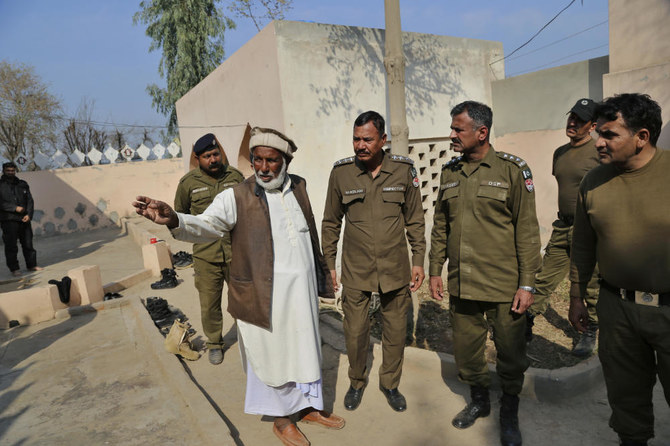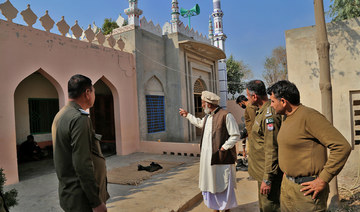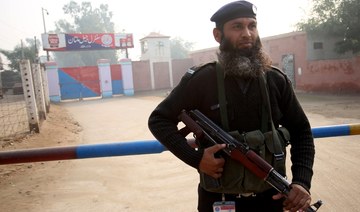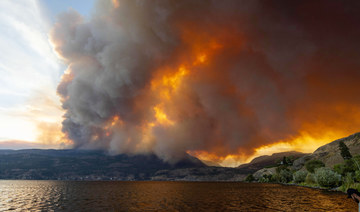MULTAN, Pakistan: An enraged mob stoned to death a middle-aged man for allegedly desecrating the Qur’an in a remote village in eastern Pakistan, police said Sunday.
The custodian of a local mosque said he saw the man burning the Muslim holy book inside the mosque Saturday evening and told others before informing police, according to police spokesman Chaudhry Imran. The violence took place in a village in the district of Khanewal in Punjab province.
Imran said police rushed to the scene, where a man was found surrounded by an angry crowd. Officer Mohammad Iqbal and two subordinates tried to take custody of the man but the group began throwing stones at them, seriously injuring Iqbal and slightly injuring the other two officers.
Munawar Gujjar, chief of Tulamba police station, said he rushed reinforcements to the mosque but they did not arrive before the mob had stoned to death the man and hung his body from a tree.
Gujjar said the victim was identified as Mushtaq Ahmed, 41, of a nearby village.
“The ill-fated man has been mentally unstable for the last 15 years and according to his family often went missing from home for days begging and eating whatever he could find,” he said. He said the body was handed over to the family.
Mian Mohammad Ramzan, the mosque custodian, said he saw smoke inside the mosque, which is adjacent to his home, and rushed over to investigate. He found one Qur’an burned and saw a man attempting to burn another. He said people were starting to arrive for evening prayers as he was shouting for the man to stop.
Witnesses said a police team that reached the village before the stoning began took custody of a man but the mob snatched him away from them and beat the police as they tried to rescue him.
Later, more officers and constables reached the scene and took custody of the body, they said.
Gujjar, the area police chief, said investigators were scanning available videos to try to identify the assailants. He said police had so far detained about 80 men living in the mosque’s surroundings but that about 300 suspects took part.
Prime Minister Imran Khan expressed his anguish over the incident and said he was seeking a report from Punjab’s chief minister on the police handling of the case. He said they “failed in their duty.”
“We have zero tolerance for anyone taking the law into their own hands and mob lynching will be dealt with with the full severity of the law,” he said in a tweet hours after the incident.
Khan also asked the Punjab police chief for a report on the actions taken against perpetrators of the lynching.
The killing comes months after the lynching of a Sri Lankan manager of a sporting goods factory in Sialkot in Punjab province on Dec. 3 who was accused by workers of blasphemy.
Mob attacks on people accused of blasphemy are common in this conservative Islamic nation. International and national rights groups say blasphemy accusations have often been used to intimidate religious minorities and settle personal scores. Blasphemy is punishable by death in Pakistan.
Man accused of blasphemy stoned to death by mob in Pakistan
https://arab.news/zs5a8
Man accused of blasphemy stoned to death by mob in Pakistan

- The ill-fated man has been mentally unstable for the last 15 years and according to his family often went missing from home for days begging and eating whatever he could find,” he said
Russia downs 16 Ukraine-launched missiles, 31 drones

- Russian defense ministry: 12 guided missiles were launched from a Ukrainian Vilkha multiple rocket launcher
- Four Storm Shadow aircraft guided missiles and seven drones were downed over Crimea
Five houses were damaged in Belgorod, but according to preliminary information, there were no injuries, Governor Vyacheslav Gladkov wrote on the Telegram messaging app.
On Sunday, 15 people were killed in Belgorod when a section of an apartment block collapsed after being struck by fragments of a Soviet-era missile, launched by Ukraine and shot down by Russian forces, Russia said.
The Russian defense ministry said on Monday the 12 guided missiles were launched from a Ukrainian Vilkha multiple rocket launcher.
The ministry also said four Storm Shadow aircraft guided missiles and seven drones were downed over Crimea, eight drones were destroyed over the Kursk region and four were intercepted over the Lipetsk region.
A drone sparked a short-lived fire at an electrical substation in the Kursk region, Igor Artamonov, the governor of the region in Russia’s south, wrote on Telegram.
“There are no casualties. The fire in the territory of the electrical substation is being extinguished,” Artamonov said.
Reuters could not independently verify the reports.
There was no immediate comment from Ukraine. Kyiv says that targeting Russia’s military, transport and energy infrastructure undermines Moscow’s war effort and is an answer to the countless deadly attacks by Russia.
Western Canada blazes cause evacuations, air quality concerns

- Authorities issued an evacuation order for a community in British Columbia and warn of poor air quality across provinces
TORONTO: The season’s first major wildfires have spread to roughly 10,000 hectares across Western Canada on Sunday as authorities issued an evacuation order for a community in British Columbia and warned of poor air quality across provinces.
In British Columbia, thousands of residents in Northern Rockies Regional Municipality and Fort Nelson First Nations were evacuated as the nearby blaze nearly doubled to 4,136 hectares.
Northern Rockies Regional Municipality Mayor Rob Fraser in a TV interview said most of the 3,500 residents in and around Fort Nelson had been evacuated.
Fort Nelson First Nation, seven kilometers from the town, also issued an evacuation order for Fontas, an Indigenous community.
Across the border in Alberta, residents of Fort McMurray, an oil hub which suffered extensive damage from wildfires in 2016, were asked to prepare to leave.
However, by the end of the day, favorable weather helped by a shower forecast tamed fire growth at Fort McMurray. Authorities said they expected fire activity to remain low with more showers expected on Monday.
Alberta continued to stress the two wildfires were extreme and out of control and recorded 43 active fires, including one located 16km southwest of Fort McMurray. By Sunday, authorities revised the area affected by fire to 6,579 hectares, much larger than what was reported on Friday.
Fraser said the fire was started by a tree blown down by strong winds falling onto a power line.
Six crews of wildland firefighters, 13 helicopters and airtankers were taming the fire on Sunday, said Alberta authorities.
Evacuation alerts were in place for Fort McMurray, Saprae Creek Estates and expanded to Gregoire Lake Estates and Rickards Landing Industrial Park.
Although there is no immediate risk to these communities, the alert ensures residents are prepared to evacuate if conditions change.
Smoke in Fort McMurray on Saturday was coming from fires in northern British Columbia, Alberta said.
Environment Canada issued a special air quality statement that extends from British Columbia to Ontario on Sunday.
Last year, a veil of smoke blanketed the US East Coast, tinging the skies a fluorescent orange as smoke reached parts of Europe as hundreds of forest fires burnt millions of acres of land and forced about 120,000 people to leave their homes.
The federal government has warned Canada faces another “catastrophic” wildfire season as it forecast higher-than-normal spring and summer temperatures across much of the country, boosted by El Nino weather conditions.
Canada experienced one of its warmest winters with low to non-existent snow in many areas, raising fears ahead of a hot summer triggering blazes in forests and wildlands amid an ongoing drought.
India to sign 10-year pact with Iran for Chabahar port management— report

- India has been developing port to transport goods to Iran, Afghanistan and Central Asia to avoid Karachi
- Sanctions imposed by Washington on Iran have slowed down Chabahar port’s development work
NEW DELHI: India is likely to sign an agreement with Iran on Monday to manage the southeastern Iranian port of Chabahar for the next 10 years, the Economic Times reported.
India Shipping Minister Sarbananda Sonowal is likely to travel to Iran to sign the agreement, the report said, citing unidentified sources.
The Indian government did not immediately respond to a request for comment.
India has been developing a part of the port in Chabahar, which is located on Iran’s southeastern coast along the Gulf of Oman, as a way to transport goods to Iran, Afghanistan and central Asian countries that avoids the port of Karachi in its rival Pakistan.
US sanctions on Iran, however, have slowed down the port’s development.
India vote to resume with Kashmir poised to oppose Modi

- Jammu and Kashmir has deeply resented Modi government’s 2019 snap decision to bring territory under its control
- Rebel groups opposed to Indian rule have waged an insurgency since 1989 on frontier controlled by New Delhi
SRINAGAR, India: India’s six-week election is set to resume Monday including in Kashmir, where voters are expected to show their discontent with dramatic changes in the disputed territory under Prime Minister Narendra Modi’s government.
Modi remains popular across much of India and his Hindu-nationalist Bharatiya Janata Party (BJP) is widely expected to win the poll when it concludes early next month.
But his government’s snap decision in 2019 to bring Kashmir under direct rule by New Delhi — and the drastic security clampdown that accompanied it — have been deeply resented among the region’s residents, who will be voting for the first time since the move.
“What we’re telling voters now is that you have to make your voice heard,” said former chief minister Omar Abdullah, whose National Conference party is campaigning for the restoration of Kashmir’s former semi-autonomy.
“The point of view that we want people to send out is that what happened... is not acceptable to them,” he told AFP.
Kashmir has been divided between India and Pakistan since their independence in 1947. Both claim it in full and have fought two wars over control of the Himalayan region.
Rebel groups opposed to Indian rule have waged an insurgency since 1989 on the side of the frontier controlled by New Delhi, demanding either independence or a merger with Pakistan.
The conflict has killed tens of thousands of soldiers, rebels and civilians in the decades since, including a spate of firefights between suspected rebels and security forces in the past month.
Violence has dwindled since the Indian portion of the territory was brought under direct rule five years ago, a move that saw the mass arrest of local political leaders and a months-long telecommunications blackout to forestall expected protests.
Modi’s government says its canceling of Kashmir’s special status has brought “peace and development,” and it has consistently claimed the move was supported by Kashmiris.
But his party has not fielded any candidates in the Kashmir valley for the first time since 1996, and experts say the BJP would have been roundly defeated if it had.
“They would lose, simple as that,” political analyst and historian Sidiq Wahid told AFP last week.
The BJP has appealed to voters to instead support smaller and newly created parties that have publicly aligned with Modi’s policies.
But voters are expected to back one of two established Kashmiri political parties calling for the Modi government’s changes to be reversed.
India’s election is conducted in seven phases over six weeks to ease the immense logistical burden of staging the democratic exercise in the world’s most populous country.
More than 968 million people are eligible to vote in India’s election, with the final round of polling on June 1 and results expected three days later.
Turnout so far has declined significantly from the last national poll in 2019, according to election commission figures.
Analysts have blamed widespread expectations that Modi will easily win a third term and hotter-than-average temperatures heading into the summer.
India’s weather bureau has forecast more hot spells in May and the election commission formed a taskforce last month to review the impact of heat and humidity before each round of voting.
Japan’s military build-up strained by sexual harassment issues

- Calls to root out harassment and increase the number of servicewomen come as aging Japan faces rising threats from China, North Korea and Russia and navigates the burdensome legacy of its wartime past
TOKYO: As Japan embarks on a major military build-up, it’s struggling to fill its ranks with the women that its forces need and its policymakers have pledged to recruit. Following a wave of sexual harassment cases, the number of women applying to join the Self-Defense Forces (SDF) decreased by 12 percent in the year ending March 2023, after several years of steady growth. Some victims have said an entrenched culture of harassment could deter women from signing up.
But nine months after the defense ministry pledged to take drastic measures, it has no plans to take action on a key recommendation issued by an independent panel of experts — implementing a national system for reviewing anti-harassment training standards — according to two ministry officials responsible for training.
The government-appointed panel had identified in a report published in August that the military’s superficial harassment education — which made only limited mention of sexual harassment — and a lack of centralized oversight of such training were contributing factors to cultural problems within the institution.
The head of the panel, Makoto Tadaki, said some training sessions — one of which Reuters attended — were at odds with the gravity of the situation.
A servicewoman who is suing the government over an alleged sexual harassment incident also said in an interview that the education she received over the past 10 years was ineffective.
Calls to root out harassment and increase the number of servicewomen come as aging Japan faces rising threats from China, North Korea and Russia and navigates the burdensome legacy of its wartime past.
Women make up just 9 percent of military personnel in Japan, compared to 17 percent in the United States, Tokyo’s key security ally.
The SDF referred Reuters’ questions to the defense ministry, which said in an emailed response that harassment “must never be allowed, as it destroys mutual trust between service members and undermines their strength.”
The ministry said it had hosted harassment prevention lectures by external experts since 2023, made sessions more discussion-based and planned to invite specialists to review its training this year.
It did not respond to questions on whether it would implement the panel’s recommendation to centralize oversight of training. After ex-soldier Rina Gonoi went public with allegations of sexual assault in 2022, the defense ministry conducted a survey that year that uncovered more than 170 alleged sexual harassment incidents in the SDF. Another alleged victim was an Okinawa-based servicewoman who accused a senior of making lewd remarks toward her in 2013. She was then publicly named in harassment training materials distributed to her colleagues in 2014, she told Reuters. The alleged perpetrator was not identified in the materials.
Reuters does not name alleged victims of sexual harassment. Her allegations were corroborated with documents in the lawsuit she filed last year, after she said she exhausted an internal complaints process.
HAPHAZARD TRAINING
The defense ministry offers an annual online module on general harassment. It also provides training materials to officers for in-person sessions, but doesn’t offer training on delivering harassment education and doesn’t track how or when the officers carry out harassment training, the two defense officials said.
The officials, who spoke on condition of anonymity due to the sensitivity of the matter, justified the existing system as offering flexibility to commanders.
The six experts concluded in their review that existing training amounted to “generic, superficial statements” that were “not effective in helping people apply the training in the real world.”
In April, Reuters attended a harassment prevention course delivered by an external instructor to over 100 mid-ranking military officers at a base on the outskirts of Tokyo.
Instructor Keiko Yoshimoto presented harassment as a communication issue and focused discussions on generational differences and how they played out in preferences for types of cars and flavours of crisps.
“Generational differences make it hard for people to communicate,” she said, adding that people should understand the basics of communication before they could deal with specifics around sexual harassment.
Law professor Tadaki, who separately witnessed part of Yoshimoto’s session, said it “did not feel like the sort of training you would expect against a backdrop of there being so many cases of harassment surfacing.”
He added that it would likely take more time to increase oversight over the quality of training.
Two months after the panel issued its report, local media reported that a sailor had in 2022 been ordered against her will to meet a superior that she had accused of sexual harassment. She later quit the SDF.
Gonoi and the Okinawa-based servicewoman have criticized the system as inadequate.
“People would say ‘everyone put up with that kind of behavior, it was normal back in our time,’ – but these issues are being passed down to my generation because nothing was done to stop it,” the servicewoman told Reuters in March.
She added that the harassment training she has since received was often poorly conducted and that more centralized oversight was needed: “Rather than trying to make a point about sexual harassment, (officers) pick materials that are easy to teach, something that will fit into the time they have.”
FEAR OF COMPLAINTS
The defense ministry officials said that training on sexual harassment largely takes place within a broader anti-harassment curriculum. At the two-hour training session attended by Reuters, about two minutes were dedicated to sexual harassment.
When Reuters asked about sexual harassment incidents during interviews with the officials, as well as two senior uniformed officers, they responded by speaking about general harassment.
The officials said it was challenging to give standardised training on harassment because service members in high-stress environments may give orders in a direct way that is unusual in other circumstances.
The two officers said there were concerns within the military that too much focus on harassment could create operational issues and one suggested it might lead to unfair complaints.
The defense ministry said in a statement that it does not tolerate abuse and that its training aims to ensure commanders do not “hesitate to give necessary guidance on the job because they are concerned about harassment.”
Tadaki, the professor, said Japan could learn from other militaries.
“The US, UK, and France have a much clearer focus on preventing harassment from its root causes so its prevention program is structured around improving the internal climate and culture of its organization,” he said.
















